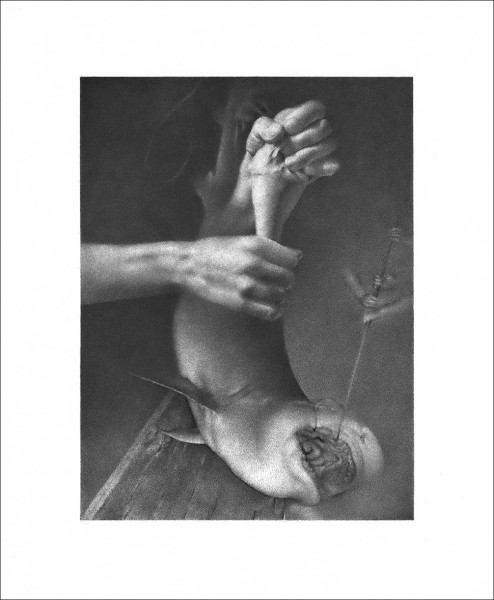
Pietà, chromatic ink on paper, 17 × 14 in | 43 × 35 cm
Sometimes fantastic, sometimes mundane, and sometimes even unidentifiable, Robles de Medina’s figures are sensuous, distant, and enigmatic. The largest of the drawings are of modest size. Move in close, and the reward is masterful mark-making through nearly incomprehensible degrees of gradation. But the veil of mystery never quite lifts. Like the sculptor who searches for the desired form by chipping away what isn’t that form, Robles de Medina’s visual taxonomy of sharks, fires, friends, people in the market, and himself, is part of a personal search for his own identity.
—
Excerpt from Louis Mason’s introduction for Robles de Medina’s solo exhibition with Praz Delavallade in Los Angeles, 2019:
“When I think about X I think about the distinction between excavation and composition—you compose an image and then you must use the tools you have to excavate it. He tells me stories about weeping, about dedication, and a rigorous commitment to formalism over many years. Composition is dramatic and demonstrative and discursive.
It is also the condition of the digital that insists against the formalism of everything X produces, and that makes his drawings sharp and timely. It holds the pictures in tension inside of their framing. But it is not so uncommon to find young, intelligent artists with this fluency—our training is obsessed with the choppy endless churn of formal experimentation. It would be trite to insist on mastery of form as some point of difference and I want to avoid this at all costs—I think that instead of an appeal to conservatism or formal stability (a good investment) it is the slippage outside of critical time that animates this process that I have called excavation.
Watching X in the studio working under the big lights is like watching a technical (even an industrial) process, and his shows and texts are contextualized by this commitment to a time scale that cannot be dissected using our readymade tools—at least not without bad faith caricature. To excavate these spaces (flooded buildings, burning facades; scenes of disasters now long in the past) is to labour under the strict conditions of this opacity. It is to treat your own clear vision as contact with the face of another. You really love this other. You can trust them never to betray their human origins. The face is tough as diamond but I think that, with time, an excavation is possible.”

Pietà, chromatic ink on paper, 17 × 14 in | 43 × 35 cm